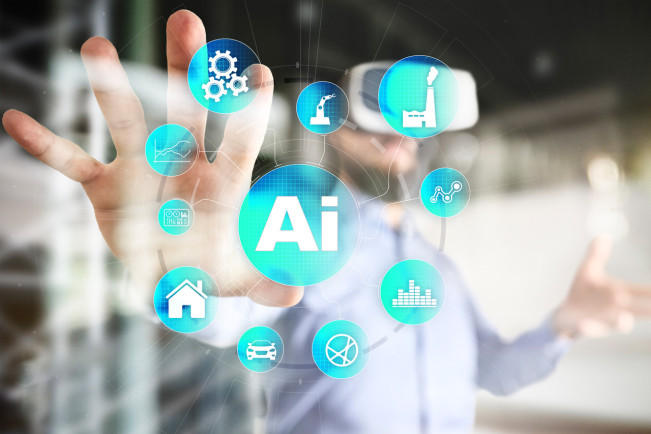Artificial Intelligence Technology Trends That Are Vital To Businesses

Artificial Intelligence Technology Trends That Are Vital To
Businesses
This article aims to outline the new and current trends in
artificial intelligence that will appear in 2020 and will continue to grow in
2021. Companies can predict the future of artificial intelligence in 2022 based
on trends and successfully reduce risks.
According to the 2020 McKinsey Global Artificial
Intelligence (AI) survey, in 2020, more than 50% of companies have adopted
artificial intelligence in at least one business department or functional
department, so we have witnessed the emergence of new artificial intelligence
trends. Organizations apply artificial intelligence tools to create more value,
increase revenue and customer loyalty. Leading AI companies invest at least 20%
of earnings before interest and taxes (EBIT) in AI. As COVID-19 accelerates
digitization, this number may increase. The blockade has led to a surge in
online activities and the massive use of artificial intelligence in business,
education, administration, and social fields.

This article aims to outline the new and current trends in
artificial intelligence that will appear in 2020 and will continue to grow in
2021. Companies can predict the future of artificial intelligence in 2022 based
on trends and successfully reduce risks.
AI adoption trends
The level of AI adoption varies from industry to industry.
Using the data mentioned in the McKinsey Global Artificial Intelligence Survey,
we can highlight four leading industries: high-tech, telecommunications,
automotive, and assembly.
The company applies artificial intelligence to service
operations, service or product design, advertising, and sales. In terms of
investment, the field of drug discovery and development has received the most
funds-in 2020, the total assets will exceed 13.8 billion U.S. dollars, an
increase of 4.5 times over the previous year.
If applied to inventory and parts optimization, pricing and
promotion, customer service analysis, sales and demand forecasting, artificial
intelligence will drive the highest revenue growth. Use cases for reporting
cost reductions are related to optimizing talent management, contact center
automation, and warehouse automation.
Artificial intelligence technology trends
In 2021 and the next few years, artificial intelligence will
be used to simplify operations and improve efficiency. Companies should try to
benefit from commercial applications of artificial intelligence by improving IT
infrastructure and data management. But not every AI model deployed can be
helpful to the company and suitable for performance monitoring. We will focus
on the artificial intelligence trends that may become mainstream in 2021-2022.
Trend 1: AI for security and surveillance
Artificial intelligence technology has been applied to face
recognition, voice recognition and video analysis. These technologies
constitute the best combination of surveillance. Therefore, by 2021, we can
foresee the massive use of artificial intelligence in video surveillance.
Artificial intelligence is conducive to the flexible setting
of the security system. Previously, engineers spent a lot of time configuring
the system because it was activated when a certain number of pixels on the
screen changed. Therefore, there are too many false positives. These alarms are
caused by fallen leaves or running animals. Thanks to artificial intelligence,
the security system can recognize objects, which contributes to more flexible
settings.
Artificial intelligence in video surveillance can detect
suspicious activity by focusing on abnormal behavior patterns instead of faces.
This ability can create safer public and private spaces by identifying
potential threats. This AI-driven video solution may also help logistics,
retail, and manufacturing.
Another niche that offers prospects for artificial
intelligence applications is speech recognition. Technology related to speech
recognition can determine identity. Identity refers to a person's age, gender,
and emotional state. Voice recognition for monitoring may be based on the same
principles as Alexa or Google Assistant. A feature suitable for security and
surveillance is the built-in anti-spoofing model that can detect synthesized
and recorded speech.
One of the most critical security technologies is biometric
face recognition. Different malicious applications try to trick the security
system by providing fake photos instead of real images. In order to prevent
this situation, a variety of anti-spoofing technologies are currently being
developed and used on a large scale.
Trend 2: Artificial intelligence in real-time video
processing
The challenge in dealing with real-time video streams is
processing the data pipeline. The engineer’s goal is to ensure accuracy and
minimize video processing delays. And artificial intelligence solutions can
help achieve this goal.
In order to implement an AI-based approach in real-time
video processing, we need a pre-trained neural network model, a cloud
infrastructure, and a software layer for application user scenarios. Processing
speed is critical for real-time streaming, so all these components should be
tightly integrated. For faster processing, we can parallelize the process or
improve the algorithm. Process parallelization is achieved through file
splitting or using pipeline methods. This pipeline architecture is the best
choice because it does not reduce the accuracy of the model and allows the use
of AI algorithms to process video in real time without any complexity. In
addition, for the pipeline architecture, additional effects that imply face
detection and blur can be applied.
Modern real-time stream processing is inseparable from the
application of background removal and blurring. As COVID-19 has contributed to
the emergence and popularization of new trends in video conferencing, the
demand for these tools has increased. These trends will be actively developed
because, according to GlobeNewswire, the global video conferencing market is
expected to grow from US$9.2 billion in 2021 to US$22.5 billion in 2026.
There are many ways to develop tools for background removal
and blurring in real-time video. The challenge is to design a model that
separates the person in the frame from the background. Neural networks that can
perform such tasks can be based on existing models such as BodyPix, MediaPipe,
or PixelLib. After selecting the model, there is still the challenge of
integrating it with the appropriate framework and organizing the best execution
process through the application of WebAssembly, WebGL or WebGPU.
Trend 3: Generative artificial intelligence for content
creation and chatbots
Modern AI models can generate very high-quality text, audio,
and images, which are almost indistinguishable from non-synthetic accurate data.
The core of the text is natural language processing (NLP).
The rapid development of NLP has led to the emergence of language models. For
example, Google and Microsoft have successfully used the BERT model to
supplement their search engines.
How can the development of NLP-related technologies promote
the development of the company? First, a chatbot can be created by combining
NLP and AI tools. According to Business Insider, the chatbot market is expected
to reach $9.4 billion in 2024, so let us highlight the ways in which companies
benefit from the implementation of AI-driven chatbots.
In addition to chatbots, NLP is the core of other
cutting-edge technology solutions. One example is NLP text generation that can
be used in business applications.
The recently launched GPT-3 model allows AI engineers to
generate an average of 4.5 billion words per day. This will enable a large
number of downstream applications of AI to be used for socially beneficial and
low-value purposes. This has also prompted researchers to invest in technology
to detect generative models. Please note that in 2021-2022, we will witness the
arrival of GPT-4-"Artificial General Intelligence AI".
Going back to generative AI, we need to focus on GAN, the
generative adversarial network, which can create images that are
indistinguishable from artificially generated images. This may be non-existent
images of people, animals, objects, and other types of media (such as audio and
text). Now is the best time to implement GAN and use its capabilities. They can
model the distribution of real data and learn useful representations to improve
AI pipelines, protect data, find anomalies, and adapt to specific
real-world cases.
Trend
4. AI-driven QA and inspection
The most
compelling branch of computer vision is artificial intelligence inspection. Due
to the application of deep learning models to improve accuracy and performance,
this direction has been booming in recent years. The company began to invest in
computing and financial resources to develop computer vision systems at a
faster rate.
Automated
inspection in manufacturing means analyzing whether the product meets quality
standards. This method is also suitable for equipment monitoring.
Here
are a few use cases for AI detection:
•
Detect product defects on the assembly line
•
Identify defects in machinery and body parts
•
Baggage inspection and aircraft maintenance
•
Trend 5: Disruptive AI breakthroughs in healthcare
In recent years, the next trend related to the
implementation of AI in the healthcare industry has been widely discussed.
Scientists use AI models and computer vision algorithms to combat COVID-19,
including areas such as pandemic detection, vaccine development, drug
discovery, heat screening, facial recognition with masks, and analysis of CT
scans.
To counteract the spread of COVID-19, artificial
intelligence models can detect and analyze potential threats and make accurate
predictions. In addition, artificial intelligence helps develop vaccines by
identifying the key components that make vaccines effective.
AI-driven solutions can be used as effective tools on the
medical IoT and deal with confidentiality issues specific to the healthcare
industry. If we systematize AI use cases in healthcare, it is clear that their
goal is the same-to ensure that patients are diagnosed quickly and accurately.
Trend 6: No-code AI platforms in at least three areas
The codeless AI platform enables even small companies to
apply previously available powerful technologies only to large companies. Let
us find out why such platforms are the key AI trends for enterprises in 2021.
It takes time, expense, and relevant experience to develop
an AI model from scratch. The use of a code-free artificial intelligence
platform simplifies the task because it lowers the barriers to entry. The
advantage is:
• Fast
implementation—Compared with writing code, processing data and debugging from
scratch, it saves up to 90% of time.
• Lower
development costs-through automation, companies eliminate the need for large
data science teams.
• Easy
to use-Drag and drop functionality simplifies software development, and
applications can be created without coding.
The healthcare, financial sector, and marketing sectors all
require codeless AI platforms—although the resulting solutions cannot be highly
customized. Among the most popular no-code AI platforms, you can find Google
Cloud Auto ML, Google ML Kit, Runaway AI, CreateML, MakeML, SuperAnnotate, etc.
Enterprise-sized companies and medium-sized enterprises use
code-free platforms to develop software solutions for image classification,
recognition of gestures and sounds, and object detection.
The evolution and future of artificial intelligence
Trends indicate that the future of artificial intelligence
is promising, as artificial intelligence solutions are becoming commonplace.
Self-driving cars, robots and sensors for predictive analysis in manufacturing,
virtual medical assistants for media reporting, NLP for media reporting,
virtual education tutors, artificial intelligence assistants, and chatbots that
can replace humans in customer service— —All these artificial
intelligence-driven solutions are taking a big step forward.